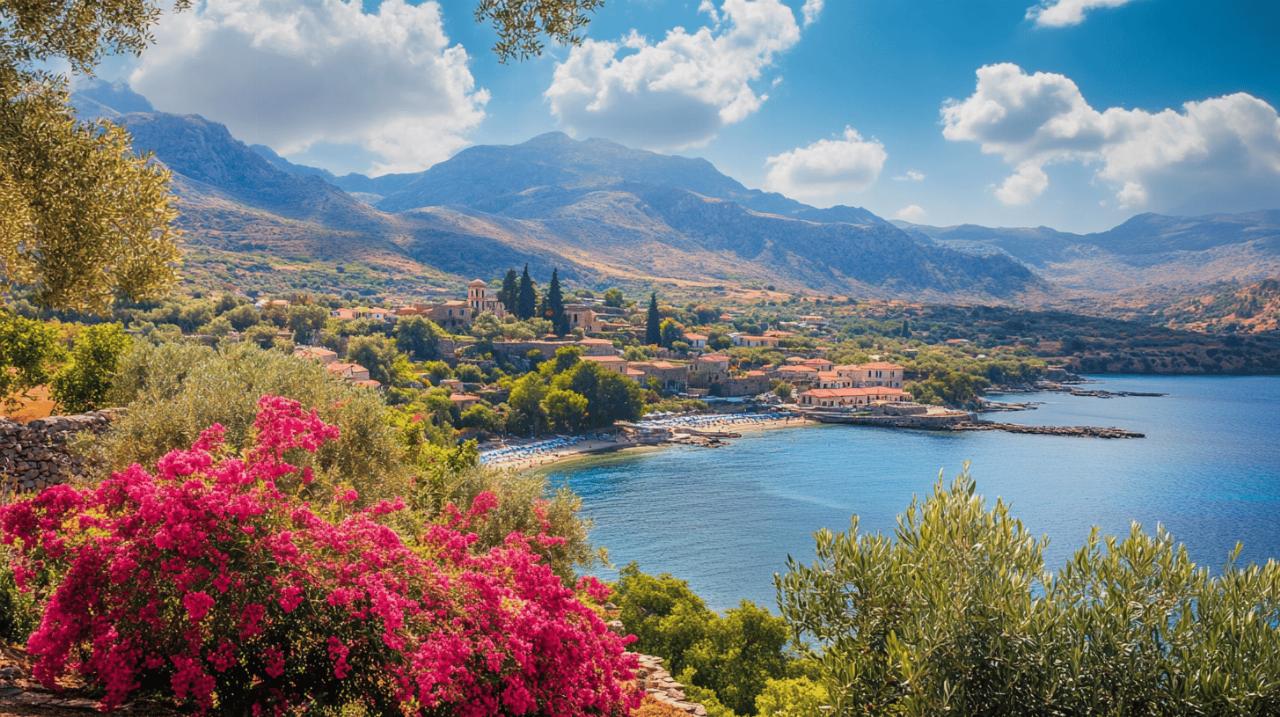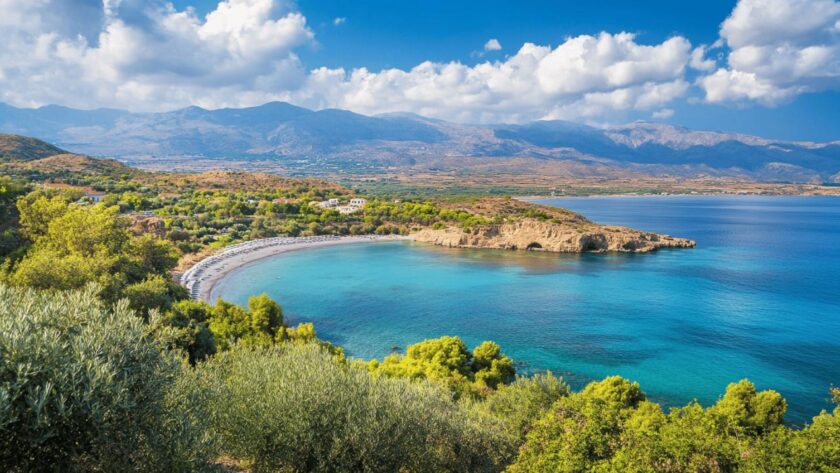Crete, the largest Greek island, captivates visitors with its diverse landscapes and rich cultural heritage throughout the year. While many travelers flock to this Mediterranean paradise during summer months, exploring Crete beyond peak season reveals a more authentic and equally enchanting experience.
Spring in crete: a blooming paradise
Spring transforms Crete into a vibrant tapestry of colors as wildflowers carpet the landscape from March through May. With temperatures ranging from 15°C to 25°C, this season offers ideal conditions for exploring the island without summer's intense heat. The moderate climate, low rainfall, and natural beauty make spring one of the most rewarding times to visit Crete.
Hiking Adventures in the Samaria Gorge
Spring breathes life into Crete's famous Samaria Gorge, creating perfect conditions for hiking enthusiasts. The gorge showcases nature in full bloom, with diverse flora and dramatic landscapes that are best appreciated during April and May. Visiting during this period means fewer crowds and a more intimate connection with one of Europe's most stunning natural attractions.
Moderate temperatures for comfortable exploration
Spring temperatures in Crete strike the perfect balance for travelers seeking outdoor adventures. Daytime averages of 20-26°C provide comfortable conditions for exploring historical sites, villages, and natural wonders without summer's sweltering heat. This pleasant climate extends daylight hours for sightseeing while keeping energy levels high for discovering the island's diverse attractions.
Autumn's charm: the perfect balance
Autumn in Crete offers a magical experience for travelers seeking the ideal balance between pleasant weather and authentic island life. From September to November, the Mediterranean climate remains inviting with temperatures typically reaching up to 27°C in September and gradually cooling to a comfortable range throughout the season. This makes autumn an exceptional time to explore the largest Greek island without the summer crowds and extreme heat.
Visiting Crete during autumn allows you to experience the island's natural beauty and cultural richness at a more relaxed pace. The gentle transition from summer creates perfect conditions for both beach enjoyment and inland exploration. Many travelers consider this season a hidden gem in the Cretan calendar, offering advantages that peak summer simply cannot match.
Warm seas and quiet beaches
One of autumn's most appealing aspects is that the sea retains its summer warmth well into the season. Sea temperatures remain comfortable for swimming, hovering around 24-25°C in September and gradually cooling to about 20°C by late October. This creates ideal conditions for enjoying Crete's famous beaches without the crowds that characterize July and August.
Beach enthusiasts will appreciate having more space to themselves at popular coastal destinations like Balos and Elafonissi. The reduced tourism pressure means you can truly appreciate these natural wonders at your own pace. Many boat rentals and cruises continue operating during this period but with more flexibility and often at better rates than during peak season. The combination of warm waters, pleasant air temperatures, and fewer visitors creates a premium beach experience that many seasoned travelers to Crete specifically seek out.
Local harvest festivals and cultural experiences
Autumn in Crete brings a wealth of cultural opportunities as the island celebrates its agricultural heritage. This season marks the grape and olive harvests, which form the backbone of traditional Cretan life. Many villages host local festivals where you can witness and participate in age-old customs while sampling fresh local produce and traditional cuisine.
Visiting Heraklion and Agios Nikolaos during autumn provides a more authentic glimpse into local life as the tourism industry winds down. You'll find locals more relaxed and willing to engage with visitors, offering genuine cultural exchanges that might be harder to come by during the busy summer months. The seasonal rhythm of Cretan life becomes more apparent, with traditional activities like olive picking becoming visible across the countryside. These authentic experiences, combined with significantly lower accommodation prices and less crowded historical sites, make autumn an ideal time for travelers seeking to connect with the true spirit of this Mediterranean island.
Winter's hidden treasures in crete
Crete, the largest Greek island in the Mediterranean, reveals a captivating charm during winter months that many travelers miss. From December through February, when temperatures hover between 10°C and 15°C along the coast, the island transforms into a serene paradise far removed from the summer crowds. While some seasonal accommodations close, this quiet season offers a genuine glimpse into authentic Cretan life at significantly lower prices.
Winter in Crete brings a different rhythm to island life. The mountains might see snow, creating a striking contrast with the mild coastal climate. Despite being the rainiest period, with December averaging 89mm of precipitation, winter days still enjoy about 8 hours of sunshine. This makes it an excellent time for cultural exploration and indoor activities while avoiding the peak season's tourist congestion.
Cultural Immersion in Heraklion and Chania
Winter presents the perfect opportunity to discover the rich cultural heritage of Crete's main cities without battling summer crowds. In Heraklion, visitors can explore the archaeological museum and nearby Knossos Palace at a leisurely pace. The winter season transforms these usually bustling sites into peaceful spaces for genuine historical appreciation.
Chania's Old Town and Venetian harbor take on a magical quality during winter. Local tavernas that cater primarily to residents rather than tourists serve authentic Cretan cuisine. Winter also brings unique cultural experiences like January's Epiphany celebrations and February's Carnival festivities, offering glimpses into traditions that summer visitors rarely witness.
Authentic village life during the cooler months
Winter unveils the true spirit of Cretan villages. Without the summer tourist influx, village squares return to their traditional role as community gathering places. Locals welcome visitors into their daily routines, from olive harvesting to raki distillation. This season provides an unmatched opportunity to engage with village customs and traditions that have shaped Cretan identity for generations.
The winter landscape offers its own beauty. Mountain villages, sometimes dusted with snow, invite travelers to experience cozy evenings by fireplaces in traditional tavernas. The rhythm of life slows down, allowing for meaningful connections with locals eager to share stories and customs. Village celebrations throughout winter months showcase authentic Cretan music, dance, and culinary traditions in their natural setting rather than as tourist performances.
Understanding crete's climate throughout the year
Crete, the largest Greek island in the Mediterranean, offers diverse experiences across all seasons. While many travelers flock to this beautiful destination during summer months, each season presents unique opportunities to discover the island's authentic charm. By understanding Crete's climate patterns throughout the year, you can select the perfect time for your visit based on your preferences and interests.
Weather patterns and planning your visit
Crete enjoys a typical Mediterranean climate with distinct seasonal variations that greatly influence travel experiences. Spring (April-May) brings mild temperatures between 15°C and 25°C, making it ideal for outdoor activities like hiking the famous Samaria Gorge amid blooming wildflowers and lush landscapes. The sea begins warming up, though not yet reaching peak temperatures.
Summer (June-September) sees temperatures climbing to 29-35°C with virtually no rainfall – July records 0mm precipitation. Sea temperatures peak at a pleasant 26°C, perfect for swimming and water sports. This high season brings 10 hours of sunshine daily but also means 100% hotel occupancy in August, larger crowds at attractions, and higher prices across the island.
Autumn (September-October) offers a sweet spot for many travelers. Temperatures remain comfortable around 25°C in September, the sea stays warm enough for swimming at 23-24°C, and tourist numbers begin declining. This creates a more relaxed atmosphere with better pricing while still enjoying favorable weather conditions.
Winter (November-March) transforms Crete into a different destination. Coastal temperatures rarely drop below 10°C, though mountain areas can see snow. December brings the highest rainfall (89mm), but winter visitors enjoy authentic local life, dramatically reduced prices, and uncrowded historical sites. The sea cools to around 16°C, making swimming less appealing.
Experiencing local traditions away from tourist season
Visiting Crete outside peak tourist season grants access to authentic cultural experiences and local traditions that many summer visitors miss. Winter months feature several significant festivities, beginning with Epiphany celebrations in January when locals gather for religious ceremonies across the island.
February brings Carnival season, when towns and villages across Crete host parades, masquerades, and traditional feasts. These events showcase authentic Cretan customs with minimal tourist presence, allowing visitors to connect more deeply with local culture.
May holds special significance with commemorations of the Battle of Crete, an important historical event for islanders. This period offers insights into Cretan history and identity through various memorial events.
Spring and autumn visits allow travelers to experience Crete's agricultural traditions firsthand. Spring brings opportunities to witness olive harvesting in rural communities, while autumn features grape harvests and wine-making celebrations in villages across the island.
For budget-conscious travelers, autumn and winter visits offer substantial savings. Hotel rates drop significantly from November through March, with occupancy falling to just 20% in January. Many accommodations offer special winter rates, though some seasonal establishments do close during this period.
The ideal time to visit ultimately depends on your travel goals. Beach enthusiasts should aim for June through August for optimal water temperatures. Those interested in hiking and outdoor exploration would benefit from spring or autumn visits. Cultural explorers seeking authentic experiences might prefer winter months when cities like Heraklion and Agios Nikolaos return to their natural rhythm, free from summer crowds.




